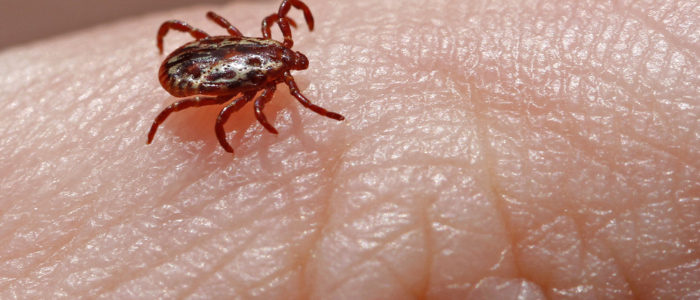Rocky Mountain spotted fever is a potentially fatal tick-borne illness. Species of ticks that can be vectors of this disease include the American dog tick, the brown dog tick, the lone star tick, and the Rocky Mountain wood tick. If symptoms are spotted early on, then an antibiotic will be an effective treatment.
Side effects of Rocky Mountain spotted fever
The Center for Disease Control and Prevention lists the following symptoms as side effects of Rocky Mountain spotted:
- fever
- headache
- abdominal pain
- vomiting
- muscle pain
- skin rash (often times absent the first few days of infection)
How to reduce the risk of Rocky Mountain spotted fever
The best way to prevent contracting this illness is to prevent being bitten by ticks. Some good news is that steps taken to prevent being bitten by a tick are the same steps that will help you avoid a slew of other bugs like mosquitoes and fleas.
Here are some tips that should keep you tick free!
- Always apply an insect repellent containing DEET, picaridin, IR3535 or oil of lemon eucalyptus when spending time outdoors, and reapply as directed on the label.
- Wear long pants, long-sleeved shirts, and closed-toe shoes when outdoors. Choose light-colored clothing that makes it easier to spot ticks and other insects.
- Keep grass cut low, as ticks are found in high grass. Remove weeds, woodpiles, and debris.
- Inspect you and your family members, as well as your pets, carefully for ticks after being outdoors.
- Keep a tick removal kit handy in the summer months. This will help you to quickly remove any ticks that may have gotten hold of you or your family.
What to do if a tick bites you
If you see a tick attached to your skin, you must remove it as soon as possible, but do not go for any of the home remedies like nail polish or essential oils. A lot of these home remedies have the goal of killing the tick by suffocating it while still embedded in your skin. The tick’s saliva is what can transmit the many diseases they carry, so suffocating the tick in your skin only prolongs your exposure to their saliva.
To remove a tick, you will need a pair of fine tipped tweezers. Grasp the tick as close the skin as possible and gently pull directly upwards. Do not twist. This could cause part of the tick’s mandibles to break off in your skin which is something you want to avoid. After removing the tick, place it in a sealable plastic bag and place it in the trash.
If you experience any fever or rash after a tick bite, call your local physician ASAP! You may have contracted a tick-borne illness like Rocky Mountain spotted fever, and early identification of tick-borne illnesses is essential for prompt treatment.
If you are experiencing issues with ticks or any other pests, call us at 800–922-2596.

